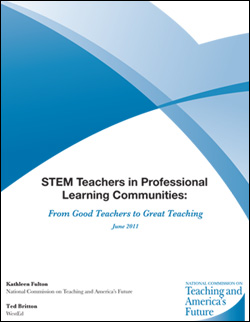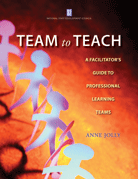STEM & Professional Learning
A MiddleWeb Blog
The National STEM Conference in Boston last week attracted over 1,500 folks – including corporate leaders, government officials, curriculum developers, and classroom teachers. They were there, of course, to discuss the crucial need for more American students to be well-educated in STEM subjects – science, technology, engineering, and math.
The basic premise is familiar to all of us involving in STEM advocacy: Student mastery of STEM subjects is essential to our economic growth, and presently we face serious challenges in developing students who can perform successfully in the STEM workplace.
The professional learning challenge
When push comes to shove, student success in STEM courses depends on teachers with the skills, knowledge and support to engage students through the engineering design process and help them discover the many upsides of STEM careers. Here are a couple of questions we can start chewing on:
• What should teachers know and be able to do to help students be successful in science, technology, engineering, and math coursework?
• What strategies can teachers use to help their students integrate, apply, and make sense of this learning?
• How do teachers prepare students to be responsible workers and citizens?
Successful teachers obviously need strong preparation and induction programs. But once they are in the classroom, teachers need a clear, logical, and ongoing system that helps them become talented practitioners and keeps them continually learning and growing throughout their careers. (Think of how rapidly society and workforce needs are changing.) We need some way to continually educate, to retain, and to support high quality STEM teachers.
A documented approach

In June 2011, with the support of the National Science Foundation and in collaboration with WestEd, the National Commission on Teaching and America’s Future (NCTAF) released “STEM Teachers in Professional Learning Communities: From Good Teachers to Great Teaching.”
The results of the study are straightforward: STEM teaching is more effective and student achievement increases when teachers join forces and develop strong professional learning communities in their schools. According to the report,
Great teaching is a team sport.”
In a nutshell, the study points out that solo teaching just doesn’t cut it. Many studies agree that teachers in professional learning teams can
- successfully engage in discussions of STEM content and how to teach it
- have a deeper understanding of science and mathematics
- be more prepared to teach science and mathematics
- use more research-based teaching methods
- pay more attention to students’ reasoning and understanding
- use more diverse methods for engaging students in problem-solving
- increase science and mathematics achievement for students
Applying what we know: 10 steps to successful STEM teacher teams

Based on eight years of researching, developing, and implementing professional learning teams (PLTs), I have some steps I’d like suggest to help set up and sustain successful teacher teams. I can elaborate on the “how to” of these particular steps in future posts.
1. Build a foundation for the STEM initiative and for PLTs. At this stage we’re interested in increasing faculty knowledge and buy-in for both STEM and for professional learning teams. This is also the time to reach consensus on what STEM is and what your school’s STEM program will look like.
2. Overview PLTs in operation. Give teachers an introduction to the sorts of activities they would engage in as members of professional learning teams who are working with STEM curriculum.
3. Organize for STEM PLTs. This is the tough part. Put the right supports and incentives in place before beginning PLTs. Prepare for teams to have job-embedded meetings each week.
4. Prepare teachers for successful interactions. Collaboration involves relationship-building. Guide teams in setting norms that build relationships and accountability.
5. Develop team outcomes and goals. Team goals are rooted in student needs – however the goals focus on teacher learning.
6. Plan for successful work. Before deciding on an initial plan, team members reflect on their assumptions, beliefs, and attitudes as well as their current practices. Their team plan includes STEM work as well as teamwork benchmarks, along with evidence of success they will collect.
7. Hold Productive Meetings. Communication is key. You’ll discuss possible communication guidelines along with helps for holding productive conversations, building trusting relationships, examining student thinking, and troubleshooting when necessary.
8. Maintain the momentum. STEM team members will need appropriate feedback and ways of engaging in reflective analysis, self-assessments, and celebrations.
9. Assess team effectiveness. Team members need to gather and analyze data on the work of the PLTs and the impact of STEM learning.
10. Facilitate successfully. Facilitating, sustaining, and supporting the STEM teams is a shared responsibility among team members and school and system leaders.
If you have some thoughts about those steps – and what else might be needed (or omitted) I’d like to learn from you. In the meantime, I plan to expand my comments on some of these steps and offer some “how to” ideas in future posts that draw on my own work with successful professional learning teams.































We have been gathering engineering and STEM resources for the past year. We launched a website, blog, and Facebook pages this spring and it just was reviewed in the July NSTA Reports.
You are cordially invited to explore Get Caught Engineering, a resource site to help teachers and parents connect “classroom learning” with real life applications in STEM: science, technology, engineering and math. Our goal is to provide lessons, blogs, ideas, and resources for hands-on engineering experiences that excite and challenge elementary children. Website: http://www.getcaughtengineering.com
And “like” our Facebook page to get continual updates on great engineering resources :
https://www.facebook.com/GetCaughtEngineering
Can’t wait to read more, Anne! I have worked on PLT’s and understand their value, but have never facilitated one. My impression has been that your step #10, Facilitate successfully, is key…
What a cool resource! Added it to my tech-girls resources @ http://www.tech-girls.org/resources.html.
Facilitation is certainly important Caroline . . . along with strong administrative support. Facilitation is generally an acquired skill so I even wonder about putting facilitation as the beginning step of the PLT process rather than at the end. Successful facilitation is a topic unto itself!
Wendy and Cheryl, I visited your website and I like what I saw! I saw real engineering lessons complete with problems for kids to solve and “space” for them to think and create. Congratulations on your energy and enthusiasm for this oh-so-needed curriculum. When you get ready to train other teachers to implement, you might try the approach suggested in the post and see if it works for you. Does your site have a Twitter handle?
Thanks for your encouragement, techkim! I have #techgirlday marked as a regular resource on Twitter, and I’ve used your resources when researching information on STEM and girls. Thanks for your tech-girl resources – they are cool as well!
I worked for several years on a STEM team–long before it was an acronym. My partners were excellent science and math teachers. As the only Liberal Arts grad in the group, I pitched in by emphasizing the role of science, math, engineering, innovation/invention in moving society forward in my history classes. We had a great time teaching this way and we believe our students did also as many have gone on to successful careers in STEM jobs. My hope is that this initiative becomes rooted in our education system. Retired now, we continue to maintain our interest and involvement in education.
What a great adventure, Joyce! You were a STEAM team (Science, Technology, Engineering, Arts, and Mathematics) well before the acronym came into being – and your students were healthier, well-rounded citizens because of it. That’s one thing I (and other bloggers) need to stress more – the place of the liberal ARTS in STEM. Thanks for your initiative, and for remaining involved in education.
Thank you all for sharing these great website with info for middle schools. I work with our two year colleges and their secondary partners, who are looking for ways to support middle school kids and to engage parents. P.S.– I tried to access that tech-girls website and got an error message, “page not found, does not exist.”
Try tech-girls.org then mouse over Educators & select Resources.